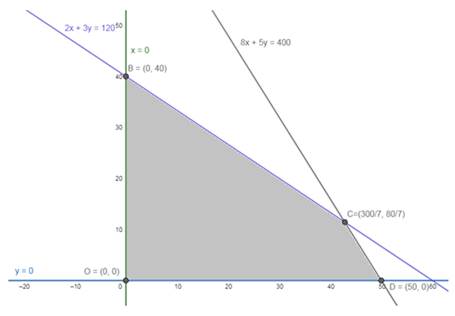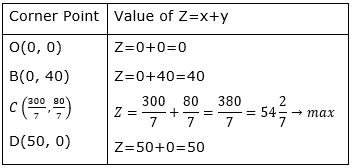Refer to Exercise 15. Determine the maximum distance that the man can travel.
Referring to the exercise 15, we get the following data:
Let the man rides his motorcycle for a distance of x km at a speed of 50km/hr then he has to spend Rs. 2/km on petrol.
let the man rides his motorcycle for a distance of y km at a speed of 80 km/hr then he has to spend Rs. 3/km on petrol.
He has at most Rs 120 to spend on petrol for total distance covered so the constraint becomes,
2x+3y≤120…………(i)
Now also given he has at most one hour’s time for total distance to be covered, so the constraint becomes
![]() {as distance=speed×time}
{as distance=speed×time}
Now taking the LCM as 400, we get
⇒ 8x+5y≤400……………(ii)
And x≥0, y≥0 [non-negative constraint]
He want to find out the maximum distance travelled, here total distance, Z =x+y
Now, we have to maximize the distance, i.e., maximize Z=x+y
So, to maximize distance we have to maximize, Z=x+y, subject to
2x+3y≤120
8x+5y≤400
x≥0, y≥0
Now let us convert the given inequalities into equation.
We obtain the following equation
2x+3y≤120⇒ 2x+3y=120
8x+5y≤400 ⇒ 8x+5y=400
x ≥ 0 ⇒ x=0
y ≥ 0 ⇒ y=0
The region represented by 2x+3y≤120:
The line 2x+3y=120 meets the coordinate axes (60,0) and (0,40) respectively. We will join these points to obtain the line 2x+3y=120. It is clear that (0,0) satisfies the inequation 2x+3y≤120. So the region that contain the origin represents the solution set of the inequation 2x+3y≤120
The region represented by 8x+5y≤400:
The line 8x+5y=400 meets the coordinate axes (50,0) and (0,80) respectively. We will join these points to obtain the line 8x+5y=400. It is clear that (0,0) satisfies the inequation 8x+5y≤400. So the region that contain the origin represents the solution set of the inequation 8x+5y≤400
Region represented by x≥0 and y≥0 is first quadrant, since every point in the first quadrant satisfies these inequations
The graph of these equations is given.

The shaded region OBCD is the feasible region is bounded, and maximum value will occur at a corner point of the feasible region.
Corner Points are O(0, 0), B(0, 40), ![]() and D(50, 0)
and D(50, 0)
Now we will substitute these values in Z at each of these corner points, we get

So from the above table the maximum value of Z is at point ![]() .
.
Hence, the maximum distance the man can travel is ![]() or 54.3km.
or 54.3km.